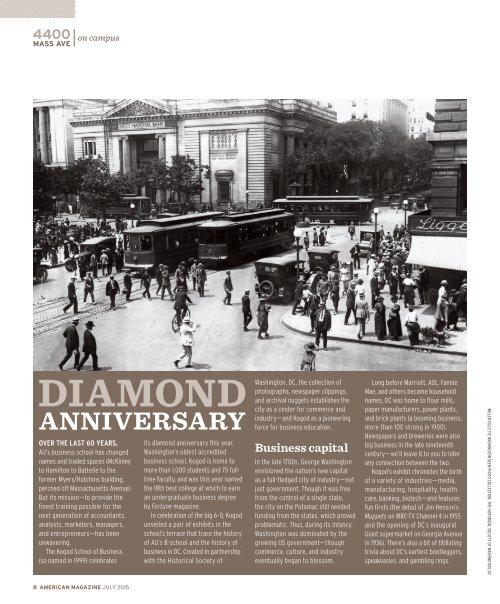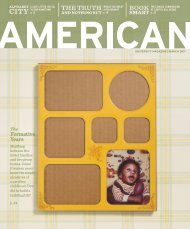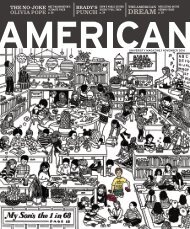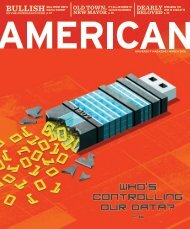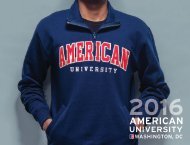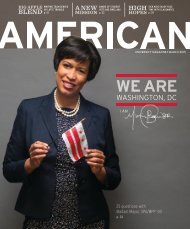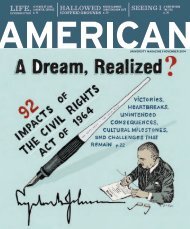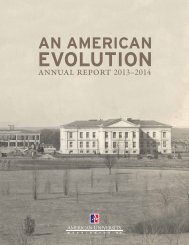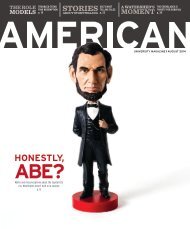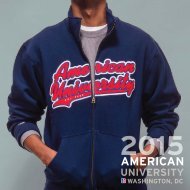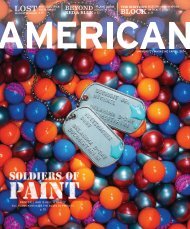American Magazine, July 2015
This issue, meet Maryland First Lady Yumi Hogan, learn about Kogod’s startup incubator, explore the Smithsonian’s new American Enterprise exhibit, hop on the Metro to Navy Yard—Ballpark, and get to know some of AU’s 1,200 Atlanta transplants. Also in the August issue: footwear on campus, 12 Eagles to follow on Twitter, and a new quiz with a tasty prize.
This issue, meet Maryland First Lady Yumi Hogan, learn about Kogod’s startup incubator, explore the Smithsonian’s new American Enterprise exhibit, hop on the Metro to Navy Yard—Ballpark, and get to know some of AU’s 1,200 Atlanta transplants. Also in the August issue: footwear on campus, 12 Eagles to follow on Twitter, and a new quiz with a tasty prize.
You also want an ePaper? Increase the reach of your titles
YUMPU automatically turns print PDFs into web optimized ePapers that Google loves.
on campus<br />
OVER THE LAST 60 YEARS,<br />
AU’s business school has changed<br />
names and traded spaces (McKinley<br />
to Hamilton to Battelle to the<br />
former Myers/Hutchins building,<br />
perched off Massachusetts Avenue).<br />
But its mission—to provide the<br />
finest training possible for the<br />
next generation of accountants,<br />
analysts, marketers, managers,<br />
and entrepreneurs—has been<br />
unwavering.<br />
The Kogod School of Business<br />
(so named in 1999) celebrates<br />
its diamond anniversary this year.<br />
Washington’s oldest accredited<br />
business school, Kogod is home to<br />
more than 1,000 students and 75 fulltime<br />
faculty, and was this year named<br />
the 18th best college at which to earn<br />
an undergraduate business degree<br />
by Fortune magazine.<br />
In celebration of the big 6–0, Kogod<br />
unveiled a pair of exhibits in the<br />
school’s terrace that trace the history<br />
of AU’s B-school and the history of<br />
business in DC. Created in partnership<br />
with the Historical Society of<br />
Washington, DC, the collection of<br />
photographs, newspaper clippings,<br />
and archival nuggets establishes the<br />
city as a center for commerce and<br />
industry—and Kogod as a pioneering<br />
force for business education.<br />
Business capital<br />
In the late 1700s, George Washington<br />
envisioned the nation’s new capital<br />
as a full-fledged city of industry—not<br />
just government. Though it was free<br />
from the control of a single state,<br />
the city on the Potomac still needed<br />
funding from the states, which proved<br />
problematic. Thus, during its infancy,<br />
Washington was dominated by the<br />
growing US government—though<br />
commerce, culture, and industry<br />
eventually began to blossom.<br />
Long before Marriott, AOL, Fannie<br />
Mae, and others became household<br />
names, DC was home to flour mills,<br />
paper manufacturers, power plants,<br />
and brick plants (a booming business,<br />
more than 100 strong in 1900).<br />
Newspapers and breweries were also<br />
big business in the late nineteenth<br />
century—we’ll leave it to you to infer<br />
any connection between the two.<br />
Kogod’s exhibit chronicles the birth<br />
of a variety of industries—media,<br />
manufacturing, hospitality, health<br />
care, banking, biotech—and features<br />
fun firsts (the debut of Jim Henson’s<br />
Muppets on WRC-TV Channel 4 in 1955<br />
and the opening of DC’s inaugural<br />
Giant supermarket on Georgia Avenue<br />
in 1936). There’s also a bit of titillating<br />
trivia about DC’s earliest bootleggers,<br />
speakeasies, and gambling rings.<br />
MILLER-GILLETTE WASHINGTON SEEN PHOTO COLLECTION, THE HISTORICAL SOCIETY OF WASHINGTON, DC<br />
8 AMERICAN MAGAZINE JULY <strong>2015</strong>


